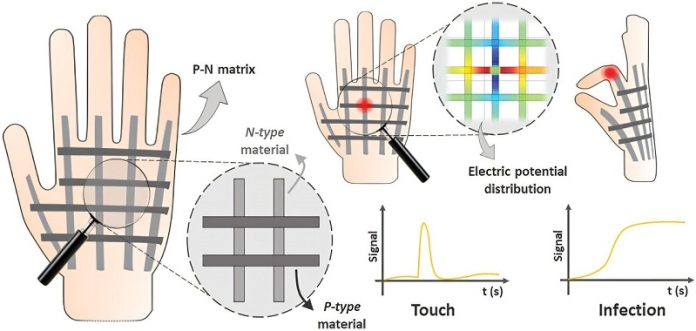
A team of researchers from the Universitat Rovira i Virgili (URV) in Spain, along with partners from the University of Porto, has created a smart skin sensor that can detect infections early by monitoring changes in skin temperature.
The breakthrough device works without batteries or an external power supply and could change the way wounds and inflammation are monitored.
The findings were recently published in the journal Advanced Science.
The new sensor was developed as part of a European research project focused on creating energy-efficient, flexible devices that could be used on the skin or other surfaces.
According to lead researcher Eduard Llobet from URV, the team wanted to move away from devices that rely on batteries and make something comfortable, adaptable, and reliable.
Temperature is a key signal in identifying skin problems like infections or delayed healing. Normally, temperature checks are done using infrared cameras or sensors that can only look at one spot at a time.
These tools also require the patient to stay still, which limits their use.
The new device solves these problems by using a network of tiny sensors called thermocouples.
These detect very small temperature changes and turn them into electrical signals, creating a detailed “heat map” of the skin that shows exactly where inflammation or infection might be starting.
The researchers tested the device on human skin using a salty solution to mimic sweat. The results were impressive. The sensor could detect changes as small as 0.4°C and react in under three seconds, even in sweaty conditions.
This means it can track how a wound is healing and alert healthcare workers to signs of infection almost immediately.
The patch is made using flexible thermoelectric materials and printed with techniques similar to those used in printing T-shirts. It sticks comfortably to the skin and can bend or stretch without breaking.
Tests showed it still worked after being bent many times, proving it is durable enough for real-life use. Silvia de la Flor from URV’s Department of Mechanical Engineering confirmed that the sensor remained functional after many stress tests.
Another big advantage is how easy it is to use. The sensor shows the temperature changes as a color map, making it simple for doctors and nurses to spot trouble areas without needing special training.
This smart sensor can be worn for several days and may be useful in preventing infections in surgical wounds, pressure sores, or other inflammatory conditions. The team is already working on upgrades, such as adding features to detect other health signals like gas levels or chemical markers.
Their goal is to make medical monitoring more personalized, convenient, and accessible for everyone.
If you care about inflammation, please read studies about turmeric: nature’s golden answer to inflammation, and what to eat to reduce chronic Inflammation.
For more health information, please see recent studies about how a plant-based diet could help ease inflammation, and Vitamin D deficiency linked to increased inflammation.
Source: KSR.



